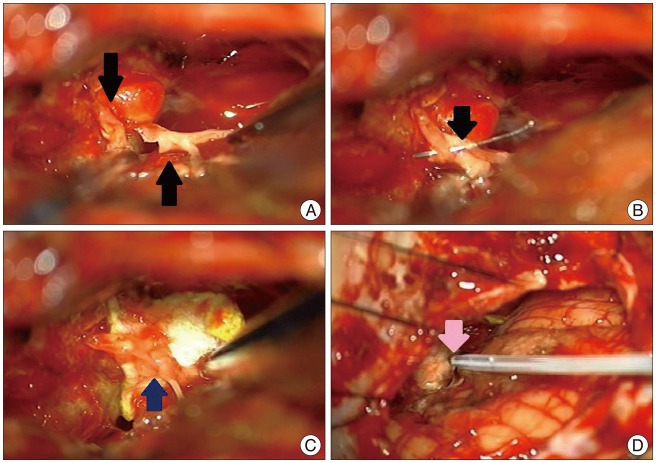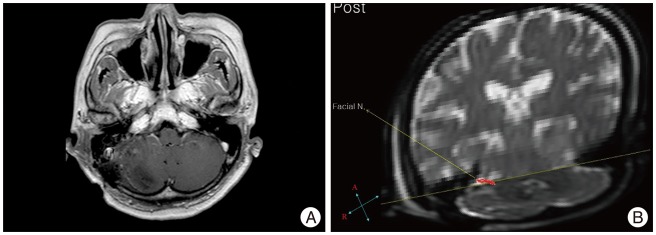J Korean Neurosurg Soc.
2014 Apr;55(4):208-211. 10.3340/jkns.2014.55.4.208.
Preservation of Facial Nerve Function Repaired by Using Fibrin Glue-Coated Collagen Fleece for a Totally Transected Facial Nerve during Vestibular Schwannoma Surgery
- Affiliations
-
- 1Department of Neurosurgery, College of Medicine, Yeungnam University, Daegu, Korea. olkim@med.yu.ac.kr
- 2Department of Physical Medicine and Rehabilitation, College of Medicine, Yeungnam University, Daegu, Korea.
- KMID: 2191094
- DOI: http://doi.org/10.3340/jkns.2014.55.4.208
Abstract
- Recently, the increasing rates of facial nerve preservation after vestibular schwannoma (VS) surgery have been achieved. However, the management of a partially or completely damaged facial nerve remains an important issue. The authors report a patient who was had a good recovery after a facial nerve reconstruction using fibrin glue-coated collagen fleece for a totally transected facial nerve during VS surgery. And, we verifed the anatomical preservation and functional outcome of the facial nerve with postoperative diffusion tensor (DT) imaging facial nerve tractography, electroneurography (ENoG) and House-Brackmann (HB) grade. DT imaging tractography at the 3rd postoperative day revealed preservation of facial nerve. And facial nerve degeneration ratio was 94.1% at 7th postoperative day ENoG. At postoperative 3 months and 1 year follow-up examination with DT imaging facial nerve tractography and ENoG, good results for facial nerve function were observed.
Keyword
MeSH Terms
Figure
Reference
-
1. Anderson DE, Leonetti J, Wind JJ, Cribari D, Fahey K. Resection of large vestibular schwannomas : facial nerve preservation in the context of surgical approach and patient-assessed outcome. J Neurosurg. 2005; 102:643–649. PMID: 15871506.
Article2. Bacciu A, Falcioni M, Pasanisi E, Di Lella F, Lauda L, Flanagan S, et al. Intracranial facial nerve grafting after removal of vestibular schwannoma. Am J Otolaryngol. 2009; 30:83–88. PMID: 19239948.
Article3. Chen DQ, Quan J, Guha A, Tymianski M, Mikulis D, Hodaie M. Three-dimensional in vivo modeling of vestibular schwannomas and surrounding cranial nerves with diffusion imaging tractography. Neurosurgery. 2011; 68:1077–1083. PMID: 21242825.
Article4. Cross T, Sheard CE, Garrud P, Nikolopoulos TP, O'Donoghue GM. Impact of facial paralysis on patients with acoustic neuroma. Laryngoscope. 2000; 110:1539–1542. PMID: 10983957.
Article5. Dumitru D, Walsh NE, Porter LD. Electrophysiologic evaluation of the facial nerve in Bell's palsy. A review. Am J Phys Med Rehabil. 1988; 67:137–144. PMID: 3041998.6. Gerganov VM, Giordano M, Samii M, Samii A. Diffusion tensor imaging-based fiber tracking for prediction of the position of the facial nerve in relation to large vestibular schwannomas. J Neurosurg. 2011; 115:1087–1093. PMID: 21962081.
Article7. Hastan D, Vandenbroucke JP, van der Mey AG. A meta-analysis of surgical treatment for vestibular schwannoma : is hospital volume related to preservation of facial function? Otol Neurotol. 2009; 30:975–980. PMID: 19668100.8. Hodaie M, Quan J, Chen DQ. In vivo visualization of cranial nerve pathways in humans using diffusion-based tractography. Neurosurgery. 2010; 66:788–795. discussion 795-796. PMID: 20305498.
Article9. House JW, Brackmann DE. Facial nerve grading system. Otolaryngol Head Neck Surg. 1985; 93:146–147. PMID: 3921901.
Article10. Magliulo G, D'Amico R, Di Cello P. Delayed facial palsy after vestibular schwannoma resection : clinical data and prognosis. J Otolaryngol. 2003; 32:400–404. PMID: 14967087.
Article11. Magliulo G, Zardo F, Damico R, Varacalli S, Forino M. Acoustic neuroma : postoperative quality of life. J Otolaryngol. 2000; 29:344–347. PMID: 11770141.12. Mori S, van Zijl PC. Fiber tracking : principles and strategies - a technical review. NMR Biomed. 2002; 15:468–480. PMID: 12489096.13. Mukherjee P, Chung SW, Berman JI, Hess CP, Henry RG. Diffusion tensor MR imaging and fiber tractography : technical considerations. AJNR Am J Neuroradiol. 2008; 29:843–852. PMID: 18339719.
Article14. Nimsky C, Ganslandt O, Buchfelder M, Fahlbusch R. Intraoperative visualization for resection of gliomas : the role of functional neuronavigation and intraoperative 1.5 T MRI. Neurol Res. 2006; 28:482–487. PMID: 16808876.
Article15. Nimsky C, Ganslandt O, Fahlbusch R. Implementation of fiber tract navigation. Neurosurgery. 2007; 61(1 Suppl):306–317. discussion 317-318. PMID: 18813159.
Article16. Nimsky C, Ganslandt O, Hastreiter P, Wang R, Benner T, Sorensen AG, et al. Preoperative and intraoperative diffusion tensor imaging-based fiber tracking in glioma surgery. Neurosurgery. 2005; 56:130–137. discussion 138. PMID: 15617595.
Article17. Roundy N, Delashaw JB, Cetas JS. Preoperative identification of the facial nerve in patients with large cerebellopontine angle tumors using high-density diffusion tensor imaging. J Neurosurg. 2012; 116:697–702. PMID: 22283188.
Article18. Samii M, Koerbel A, Safavi-Abbasi S, Di Rocco F, Samii A, Gharabaghi A. Using an end-to-side interposed sural nerve graft for facial nerve reinforcement after vestibular schwannoma resection. Technical note. J Neurosurg. 2006; 105:920–923. PMID: 17405267.
Article19. Sluyter S, Graamans K, Tulleken CA, Van Veelen CW. Analysis of the results obtained in 120 patients with large acoustic neuromas surgically treated via the translabyrinthine-transtentorial approach. J Neurosurg. 2001; 94:61–66. PMID: 11147899.
Article
- Full Text Links
- Actions
-
Cited
- CITED
-
- Close
- Share
- Similar articles
-
- Surgical Findings to Differentiate Between Facial Nerve Schwannoma and Vestibular Schwannoma
- The Management of Facial Nerve Schwannoma
- A Case of Vestibular Schwannoma Treated with Revision Middle Cranial Fossa Approach to Preserve Facial Nerve Function and Hearing Ability
- Preoperative Identification of Facial Nerve in Vestibular Schwannomas Surgery Using Diffusion Tensor Tractography
- What Causes Incomplete Facial Function Recovery in Patients with Immediate Facial Paralysis Following Vestibular Schwannoma Surgery?




